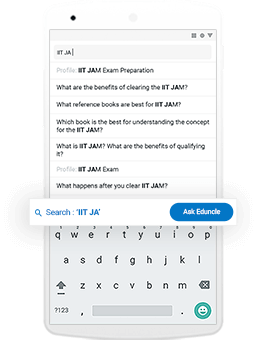Time management is very much important in IIT JAM. The eduncle test series for IIT JAM Mathematical Statistics helped me a lot in this portion. I am very thankful to the test series I bought from eduncle.
Nilanjan Bhowmick AIR 3, CSIR NET (Earth Science)- CSIR NET
- Life Sciences
1) pick an organelle..any organelle. describe its function. 2) name 7 organelles that can be found within the cytoplasm. 3) describe the pathway that proteins t
1) Pick an organelle..any organelle. Describe its function. 2) Name 7 organelles that can be found within the cytoplasm. 3) Describe the pathway that proteins travel from creation to exportation. 4) List various reasons to help support the theory of endosymbiosis. 5) Name two organelles that plant cells have and animal cells do not. 6) Which organelle creates ATP energy for cells? 7) Which organelle converts sunlight into sugar? 8) Which organelle creates ribosomes? 9) Which organelle fuses with the cell membrane to release proteins? 10)Which molecule holds the information to make a protein?
- 0 Likes
- 1 Comments
- 0 Shares
Do You Want Better RANK in Your Exam?
Start Your Preparations with Eduncle’s FREE Study Material
- Updated Syllabus, Paper Pattern & Full Exam Details
- Sample Theory of Most Important Topic
- Model Test Paper with Detailed Solutions
- Last 5 Years Question Papers & Answers
Sign Up to Download FREE Study Material Worth Rs. 500/-

















Priya sarda![best-answer]()
1) Cell Membrane. The thin, flexible outer covering of a cell and controls what enters and leaves the cell. 2) Cytoplasmic Organelles. By definition, organelles are the membrane-bound structures in a cell. The nucleus is an example. Other organelles are located in the cytoplasm such as mitochondria, chloroplasts, endoplasmic reticulum, Golgi apparatus, peroxisomes, lysosomes, vacuoles and glyoxisomes. 3)The secretory pathway refers to the endoplasmic reticulum, Golgi apparatus and the vesicles that travel in between them as well as the cell membrane and lysosomes. It's named 'secretory' for being the pathway by which the cell secretes proteins into the extracellular environment. 4) Bacteria, a prokaryote, has circular DNA, as do mitochondria and chloroplasts. This provides support for the Endosymbiotic Theory, which states that the mitochondria and chloroplast in eukaryotic cells were once aerobic bacteria (prokaryote) that were ingested by a large anaerobic bacteria (prokaryote). 5) Plant cells have a cell wall, chloroplasts, plasmodesmata, and plastids used for storage, and a large central vacuole, whereas animal cells do not. 6) Mitochondria. Mitochondria are membrane-bound cell organelles (mitochondrion, singular) that generate most of the chemical energy needed to power the cell's biochemical reactions. Chemical energy produced by the mitochondria is stored in a small molecule called adenosine triphosphate (ATP). 7) Chloroplasts work to convert light energy of the Sun into sugars that can be used by cells. It is like a solar panel that changes sunlight energy into electric energy. The entire process is called photosynthesis and it all depends on the little green chlorophyll molecules in each chloroplast. 8) Eukaryote ribosomes are produced and assembled in the nucleolus. Ribosomal proteins enter the nucleolus and combine with the four rRNA strands to create the two ribosomal subunits (one small and one large) that will make up the completed ribosome 9) The Golgi apparatus is a series of flattened sacs that sort and package cellular materials. The Golgi apparatus has a cis face on the ER side and a trans face opposite of the ER. The trans face secretes the materials into vesicles, which then fuse with the cell membrane for release from the cell. 10) Ribosomes are known as the protein factory of the cell.